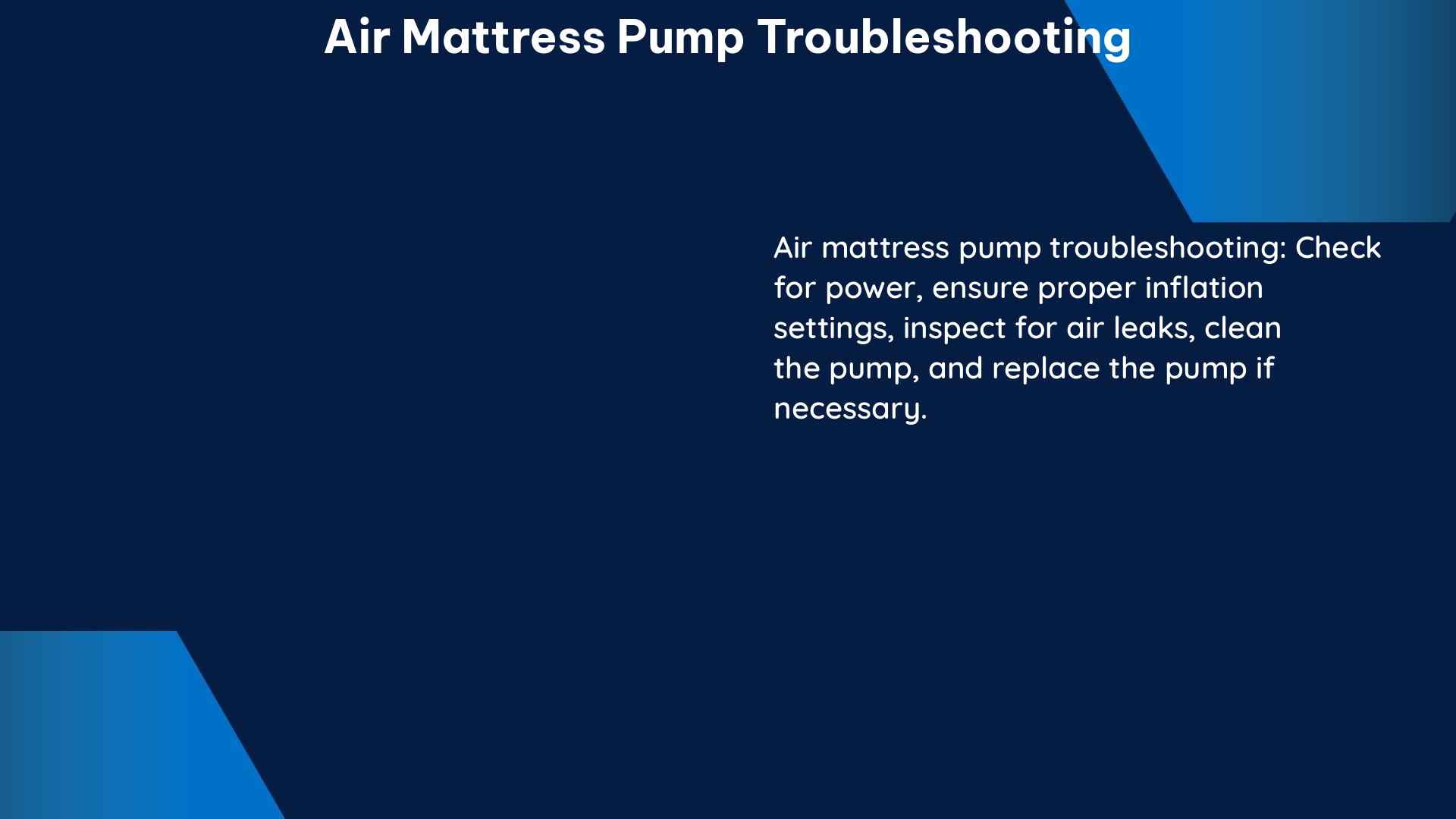When it comes to air mattress pump troubleshooting, there are several key factors to consider, including voltage, current, pressure, and mechanical issues. This comprehensive guide will provide you with a detailed, technical, and hands-on approach to diagnosing and resolving common air mattress pump problems.
Voltage Considerations
Air mattress pumps typically require a specific voltage to operate correctly. For example, the pump in the Hillrom TotalCare SpO2RT 2 air mattress has 120 VAC on it at all times, with the controlling section putting out 0 VDC to 12 VDC into the pump to go from zero to full inflation. If the voltage is too high or too low, the pump may not function correctly.
To check the voltage, you’ll need a multimeter. Measure the voltage at the pump’s power source and ensure it matches the manufacturer’s specifications. If the voltage is outside the recommended range, you may need to replace the power source or the pump itself.
Current Monitoring

The amount of current drawn by the pump can also indicate issues. For instance, if the pump is drawing high current but not moving, it may indicate that the brushes have welded themselves to the commutator on the rotor, effectively freezing the motor in place.
Using a multimeter, measure the current being drawn by the pump during operation. The manufacturer’s specifications will provide the recommended current range. If the current is significantly higher or lower than the expected value, it could be a sign of a problem.
Mechanical Troubleshooting
Mechanical problems, such as a frozen motor or a damaged fuse, can also cause the pump to malfunction. In the case of the air mattress pump mentioned earlier, the “resettable fuse” (yellow-orange thing) gets extremely hot after 1-2 seconds, indicating a problem with the electrical current.
To inspect the pump for mechanical issues, you’ll need to disassemble it. This may involve removing the housing, checking the motor for any obstructions or damage, and inspecting the fuse or other electrical components. If you find any damaged or worn-out parts, you may need to replace them.
Pressure Monitoring
The pressure at which the air mattress inflates can also be a measurable data point. If the mattress is not inflating properly, it may be due to a leak or a problem with the pump’s ability to maintain a consistent pressure.
Use a pressure gauge to measure the pressure in the air mattress during inflation. Compare the measured pressure to the manufacturer’s recommended inflation pressure. If the pressure is significantly lower than expected, check for leaks in the air bladder or the hoses.
Pump Lifespan Considerations
The length of time the pump has been in use can also be a factor in troubleshooting. Pumps, like any mechanical device, have a finite lifespan and may wear out over time, especially if they are designed to run continuously.
Keep track of the pump’s usage and consider replacing it if it’s been in service for an extended period. Manufacturers often provide information on the expected lifespan of their air mattress pumps, which can help you determine when it’s time to replace the unit.
DIY Troubleshooting Steps
Here are the steps you can take to diagnose and fix common issues with air mattress pumps:
- Checking the voltage and current: Using a multimeter, measure the voltage and current being drawn by the pump to ensure they are within the recommended ranges.
- Inspecting the pump for mechanical issues: Disassemble the pump and check for any damaged or frozen components, such as the motor or the fuse.
- Checking for leaks: If the mattress is not holding air, use soapy water to detect leaks in the air bladder or the hoses.
- Cleaning or replacing filters: If the pump has filters, clean or replace them regularly to ensure proper operation.
- Replacing worn-out components: If the pump is beyond repair, replace the pump unit or the air bladder as necessary.
Remember to always follow the manufacturer’s instructions and safety guidelines when working on your air mattress pump. If you’re not comfortable performing the troubleshooting steps yourself, consider contacting a professional for assistance.
Conclusion
Air mattress pump troubleshooting requires a methodical and technical approach. By understanding the key factors, such as voltage, current, pressure, and mechanical issues, you can effectively diagnose and resolve common problems with your air mattress pump. Follow the steps outlined in this comprehensive guide, and you’ll be well on your way to keeping your air mattress in top shape.
References:
- Medwrench Thread: Air Mattress Not Inflating
- JustAnswer Thread: Air Bed Not Inflating
- Reddit Thread: Who Can Fix an Electric Air Pump?
- Direct Supply Blog: Air Mattress Maintenance Explained
- JustAnswer Thread: Air Pump Won’t Stay Inflated
